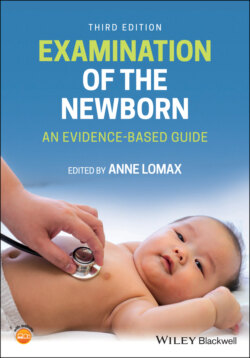Читать книгу Examination of the Newborn - Группа авторов - Страница 24
Objectives and characteristics of good history taking
ОглавлениеThe principal aim of the history‐taking exercise is to identify predictive risk indicators for those newborns that may be risk of an adverse postnatal transition extending into childhood. Families with newborns who are identified as being at risk will then benefit from early detection, intervention and treatment options. To achieve this, the history profile must be factual, accurate, concise, informative and relevant. Discussions with the parents, to gather the history, can also offer a platform that targets health awareness and safety issues to promote optimal health in the neonatal period and beyond. A review of maternal and parental lifestyle habits in general, e.g. smoking, addictive behaviours and high‐conflict relationships, can be identified, and appropriate timely referrals or support can be arranged. Other health promotion issues including BCG vaccination to high‐risk populations can be actioned.
A quality history‐taking process is largely dependent upon the skill of the practitioner. Health care professionals who conduct the newborn examination are fortunate in having pre‐existing skills that are transferable. Doctors, midwives and neonatal nurses engage in history taking on a regular basis within their daily practice. However, the underlying principles of history taking follow that of all patient groups. Howard (2008) comments upon the role of history taking in establishing trust, which in turn paves the way for the physical examination. Thus, the interpersonal skills of the NIPE practitioner can influence the quality of the history obtained. Mannerisms, eye contact, body language, patience, listening skills and empathy are all key skills that any health care professional requires to obtain a good history. If there is any deficiency in these key skills, the level of narrative imparted by the mother or father to the NIPE practitioner may be negatively affected. Stoeckle and Billings (1987), in their signature work on history taking, refer to the process as a clinical interview, and the way it is conducted will influence the communicative processes necessary to generate the clinical picture.
Parallels can be drawn between history taking for the newborn examination and maternal history taking throughout pregnancy that may illuminate any element of risk to the mother/infant dyad. In addition, engagement of the parents with the history‐taking exercise facilitates participation in the decision‐making process and the request for consent to conduct the newborn examination (NHS QIS 2008).
It is important to note that in the event of any subsequent admission to hospital for the infant, the first point of reference is the history and newborn examination. In addition, if anything was missed during the examination, e.g. cleft palate, a dislocated hip, then this may result in a complaint and possible legal action (see also Chapter 10). A thorough history can identify potential as well as actual risk of an aspect being overlooked that may later impact upon neonatal and infant outcome.
Concise and thorough history taking will also assist the NIPE practitioner to ascertain if the examination meets the healthy newborn criteria. Some aspects of the history may require midwives or neonatal nurses to refer the newborn to a medical colleague if a more detailed examination is necessary. For this reason, it is vital that maternity units have local guidelines in place to support all health care disciplines who undertake the newborn examination.
Paediatric medicine has long since considered family history as key to the clinical examination process. The family profile is informative when screening for common complex and single‐gene conditions but includes isolating genetic predispositions in some families (Green 2007). As a result, several family history‐taking checklists in the form of mnemonics have emerged to guide paediatricians. Such systems may be helpful and indeed insightful, but they cannot be fully applied to newborn history taking. However, this does highlight the importance of gathering information in an ordered manner and, most importantly, that the family history must be placed at the centre of history taking for the newborn infant.
